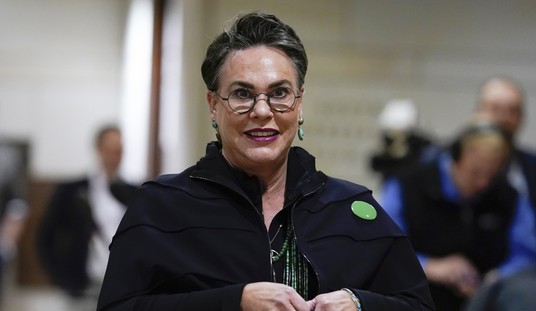When Alabama goes woke, you know it’s all over.
The University of Alabama’s Department of Theatre and Dance has announced it will assist audiences in processing upcoming plays.
According to school outlet The Crimson White, U of A’s added “diversity statements” to its list of 2020-21 productions.
As stated by TCW, the purpose is “to increase inclusivity, engage the community and promote important discussions in an entertaining way.”
The…statements address issues of diversity, equity and inclusion found in each play and encourage patrons to contemplate these issues before setting foot in the theater.
Some people prefer to process their entertainment organically. But for those hip to forego the heavy lifting, the school’s wearing a weight belt.
For example, theatergoers will soon savor the musical Legally Blonde.
Diversity Statement: … Legally Blonde has a pressing relevance in today’s society as women increasingly step into the spotlight and speak up for their equal rights and power. The musical creates a message that goes beyond promoting mere tolerance of different ideas and perspectives. It seeks out the merit in diversity so that the entire community can benefit from it.
An officer for the college’s Division of Diversity, Equity and Inclusion — Vice President and Associate Provost G. Christine Taylor — praised the arts’ potency:
“Diversity, or in this case difference, is always around each of us; however, we may not always be attuned to it. This is the power of the arts. These performances with the diversity statements reflect the arts’ tremendous ability to engage us in a deeper way with diversity, equity and inclusion.”
So if you were slow on seeing a show, doubting it would dig deeply into DEI…go ahead and get out your Sunday best.
As noted by The Crimson White, “Whether in classrooms or student organizations, the UA Department of Theatre and Dance is advocating for diversity, equity and inclusion.”
It isn’t the school’s first time to make news for modernity. In May 2020, a professor offered instructions on how to destroy statues:
My Bona Fides: I'm an Egyptologist. I have worked in Egypt for 20 years and know a lot about ancient Egyptian architecture. Especially how they raised obelisks.
— Dr. Sarah Parcak (@indyfromspace) June 1, 2020
For every 10 ft of monument, you'll need 40+ people. So, say, a 20 ft tall monument, probably 60 people. You want strong rope attached to the chain—rope easier to hold onto versus chain. EVERYONE NEEDS TO BE WEARING GLOVES FOR SAFETY (there is a lot of safety first)
— Dr. Sarah Parcak (@indyfromspace) June 1, 2020
You have two groups, one on one side, one opposite, for the rope beneath the pointy bit and the rope 1/3 down. You will need to PULL TOGETHER BACK AND FORTH. You want to create a rocking motion back and forth to ease the obelisk from its back.
— Dr. Sarah Parcak (@indyfromspace) June 1, 2020
Here’s a rough schematic. I note this is experimental archaeology in action! Just my professional Hot Take and you may need more people, longer rope, etc. everything depends on monument size. pic.twitter.com/lzl55CSPNt
— Dr. Sarah Parcak (@indyfromspace) June 1, 2020
And in September 2019, there was this:
Whoa – University of Alabama Asst. VP and Dean of Students Resigns Over Racial Tweets and Condemnation of the U.S. Flag
https://t.co/Smz6rjdo6n— RedState (@RedState) September 6, 2019
Back to the Theatre and Dance Department, Alabama’s production of Pippin features the following:
Diversity Statement: …Pippin discusses what truly brings good to this earth by telling the story of a youth born into a life of privilege who…recognizes its negative impact on his life. Pippin’s story is narrated by the Leading Player – a character that is traditionally played by an artist of color. This is important; through The Leading Player’s narration, we see them and their inclusive troupe of players shedding light on the privileges that bring Pippin to a state of constant conflict.
The Colored Museum comes thusly:
Diversity Statement: Why is it that the same stereotypes of African-Americans have made us laugh and cry throughout our history? How has white perception influenced black culture? How can a racial narrative be both embraced and overcome? … [W]e see a study of various topics digging into the core of black culture: historical whitewashing, the fragmentation of the black psyche, identity, self-hatred, black love, black empowerment, the observation of harmful stereotypes, and the mask that black people wear in America.
And if you were sluggish toward the likely-too-white Baskerville: A Sherlock Holmes Mystery, get excited:
Diversity Statement: … [B]askerville: A Sherlock Holmes Mystery is a production that will excitedly benefit from a diverse and inclusive cast with a multitude of various voices to aid in the storytelling process.
In summary: UA’s sending up a signal — it’s diverse, equitable, and inclusive. And for all you theater buffs who find meaning in explanations of what was meant, the University of Alabama is awash in wokeness. You won’t even have to look for the lesson.
We live in an age of convenience; you can have your groceries delivered, your clothes delivered, and even your thoughts.
So goes the modern world.
So goes Diversity, Equity and Inclusion at the University of Alabama — and, if I’m correct, everywhere else, too.
-ALEX
See more pieces from me:
Professor Hovers Over Hot Water After Tolerating ‘Trans Women Are Not Women’
Medical School Hosts Seminar on ‘Body Terrorism’ Against ‘Fat LGBTQ+ People’
Find all my RedState work here.
Thank you for reading! Please sound off in the Comments section below.














Join the conversation as a VIP Member